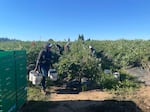Another heat wave is forecast this week, putting the test to Oregon’s temporary excessive heat rules.
The National Weather Service forecasts that starting Wednesday, at least three successive triple-digit days will hit west of the Cascades and some parts of northeast Oregon. Though not as hot as the heat wave in late June, there’s a small chance some areas will be blasted with temperatures as high as 110 degrees.
Forecast confidence continues to increase for an intense heat wave beginning on Tue. or Wed. and lasting through at least Friday. Fairly poor overnight relief is also expected, so heat exhaustion and heat stroke will be a real concern for those without access to a cool building. pic.twitter.com/YOJdtjzcQa
— NWS Portland (@NWSPortland) August 8, 2021
Meanwhile, the Oregon Department of Environmental Quality has issued an air quality advisory for Southern Oregon, eastern Lane and Linn counties. Fires from east of the Cascades and Northern California are creating unhealthy levels of smoke in the region and the agency expects the air quality advisory to be in place through at least Friday afternoon.
Other parts of the state including, Central, northeastern and northwestern Oregon may also experience short periods of wildfire smoke and haze.
DEQ advises residents in the area to wear N95 masks to protect themselves from smoke if heading outdoors and to avoid prolonged periods outside.
This week’s forecasted temperatures would be the first to exceed 100 degrees since the Oregon Occupational Safety and Health Administration adopted rules to protect workers laboring in excessive heat.
“We adopted this with the idea in mind that this isn’t going away,” Oregon OSHA’s Public Information Officer Aaron Corvin said. “We have a permanent rule in development which further recognizes the fact that this is not going away in the future when we face hot weather.”
The first set of rules adopted on July 8 require employers to provide workers access to shade and cool drinking water when temperatures reach or surpass 80 degrees. When temperatures rise above 90 degrees, employers must provide extra breaks and a cool down period. The rules also require supervisors and employees to complete training to recognize the signs of heat stress and understand the health impacts from working in excessive heat by Aug. 1.
Corvin said the agency is ramping up its resources like consultation services and technical staff support for employers. That includes help with safety and health training and helping employers understand the rule’s requirements.
Oregon OSHA will also increase the number of compliance officers visiting workplaces during the hottest days. In addition, when officers are out on inspection for other workplace related issues, they can also look into heat stress to make sure they are covering as much as they can, Corvin said.
On Aug. 2, Oregon OSHA adopted two more rules, one of which focuses on providing N95 masks when wildfire smoke is present. The other requires workers living in employer-provided housing to have access to cooling areas or rooms that stay below 78 degrees. It also requires additional training for heat-related illnesses and access to emergency services.
The changes were adopted after June’s intense heat wave led to more than 96 heat related deaths and at least four heat-related deaths on the job. One of those deaths was a farmworker who was found dead in a farm north of Salem on June 26.
The new and quickly adopted rules add more pressure for employers, said co-owner of Pearmine Farms Molly McCarger. She said it was stressful to adjust to the temporary rules during harvest season.
“It’s kind of like your homework deadline when you have to get the homework done on that day, it just adds a little extra something versus just your extra credit worksheet that you get to turn in before the end of the term,” she said.
But Pineros y Campesinos Unidos del Noroeste’s Deputy Political Director Ira Cuello-Martinez said the state’s move from guidelines to enforceable rules ensures that employers can be held accountable if they don’t protect their workers from extreme heat and smoke.
“We’ve heard of stories where folks are drinking contaminated water or having to share water in a single cup or the water is too hot or there’s no access to shade,” said Cuello-Martinez, whose group advocates for farmworkers and working Latinx families.

Farmworkers preparing blueberries they picked in Albany, Oregon, on June 28. A farmworker elsewhere was among dozens who died in a recent extreme heat wave.
Monica Samayoa / OPB
With the upcoming heat wave, Cuello-Martinez said PCUN will be looking out for how these rules will play out for both farmers and farmworkers and how both groups will be reacting to them. He also expects to hear more from farmworkers about how employers are or are not following the rules.
“We’ve heard a lot of folks already being provided water, being provided those additional breaks after two hours and being informed about the rules and that’s what we want to hear,” he said. “We want to hear that the rules are being talked about, that they are being applied to the different workplaces.”
